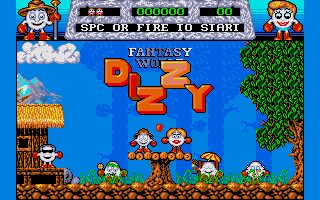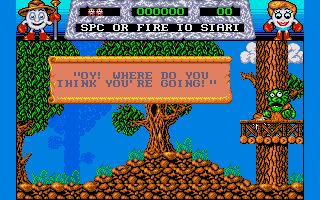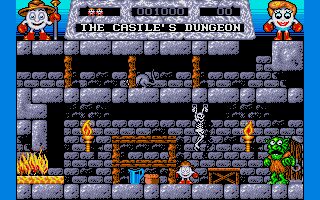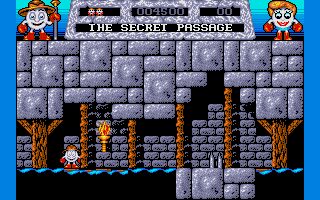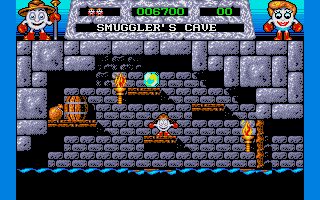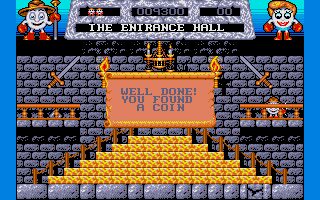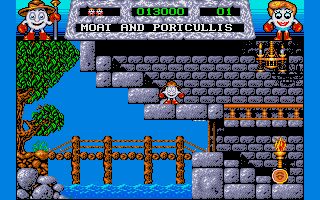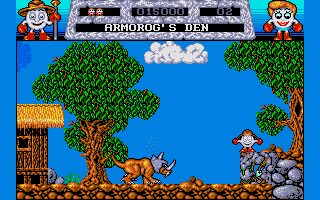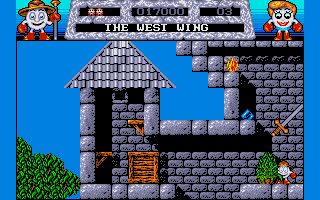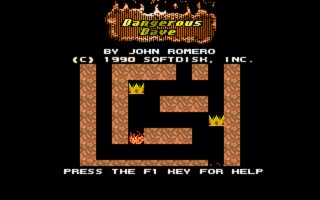Fantasy World Dizzy is a puzzle platformer developed by Codemasters and released in 1989 for the ZX Spectrum. It was later ported to various platforms, including the Amiga in 1991. Created by the Oliver Twins, this adventure marks the third entry in the beloved Dizzy series, featuring the anthropomorphic egg character in his quest to rescue his girlfriend Daisy from the evil wizard Zaks. It's the sequel to Treasure Island Dizzy.
The Amiga version represents a faithful adaptation of the original ZX Spectrum game, maintaining the core gameplay mechanics and structure while benefiting from the superior hardware capabilities of Commodore's machine. The enhanced graphics feature more detailed sprites and backgrounds, though the fundamental visual design clearly betrays its 8-bit origins with relatively simple character designs and straightforward environmental layouts. However, compared to the predecessor, Treasure Island Dizzy, the graphics of the Amiga version of Fantasy World Dizzy are clearly superior.
Fantasy World Dizzy is faithful to the conventions that would define the series throughout its evolution. Players control the perpetually rolling egg as he navigates through interconnected screens, collecting items and solving inventory-based puzzles. The gameplay combines traditional platforming elements with adventure game logic, requiring players to find the correct items and use them in appropriate locations to progress through the game world. This hybrid approach distinguishes the Dizzy series from pure platformers like Superfrog or Zool, instead positioning it closer to puzzle-adventure games such as The Lost Vikings or Goblins.
The Amiga version benefits from improved audio presentation, with a charming musical score that complements the whimsical fairy-tale atmosphere. The sound effects, while simple, are more varied and expressive than the original Spectrum version, adding personality to Dizzy's movements and interactions with the environment. The enhanced color palette allows for more vibrant and appealing visuals, though the overall art style remains deliberately cartoonish and child-friendly.
Compared to later entries in the series like Magicland Dizzy or Fantastic Dizzy, Fantasy World Dizzy feels somewhat primitive in its execution. The puzzle design, while logical, lacks the complexity and sophistication found in subsequent games. Many solutions are relatively straightforward, requiring minimal lateral thinking compared to the more challenging puzzle platformers of the era. The game world, though charming, is smaller and less elaborate than what the series would eventually offer.
The platforming mechanics are functional but lack the precision and refinement expected from dedicated platform games. Dizzy's rolling movement, while distinctive, can feel imprecise during more demanding jumping sequences. The collision detection is generally reliable, though the character's unusual shape occasionally leads to frustrating interactions with environmental hazards. These technical limitations are more apparent on the Amiga, where players might naturally expect smoother gameplay compared to the original 8-bit version.
The inventory system, a hallmark of the Dizzy series, is implemented in its most basic form here. Players can carry a limited number of items, requiring strategic thinking about what to keep and what to discard. While this mechanic adds depth to the gameplay, it can occasionally lead to backtracking when players realize they've dropped essential items in distant locations. The puzzle solutions generally follow adventure game logic, though some require specific timing or positioning that may not be immediately obvious.
Fantasy World Dizzy's appeal lies primarily in its charm and accessibility rather than its technical sophistication. The game's fairy-tale setting and gentle humor create an inviting atmosphere that works particularly well for younger players. The difficulty level is carefully calibrated to provide challenge without frustration, making it an excellent introduction to both the Dizzy series and puzzle platformers in general.
The game's 8-bit heritage is undeniable, even in its enhanced Amiga incarnation. The screen-by-screen progression, simple sprite-based graphics, and straightforward gameplay mechanics all reflect the technical limitations of its original platform. However, these apparent limitations also contribute to the game's charm, creating a pleasant experience for players of all ages.

